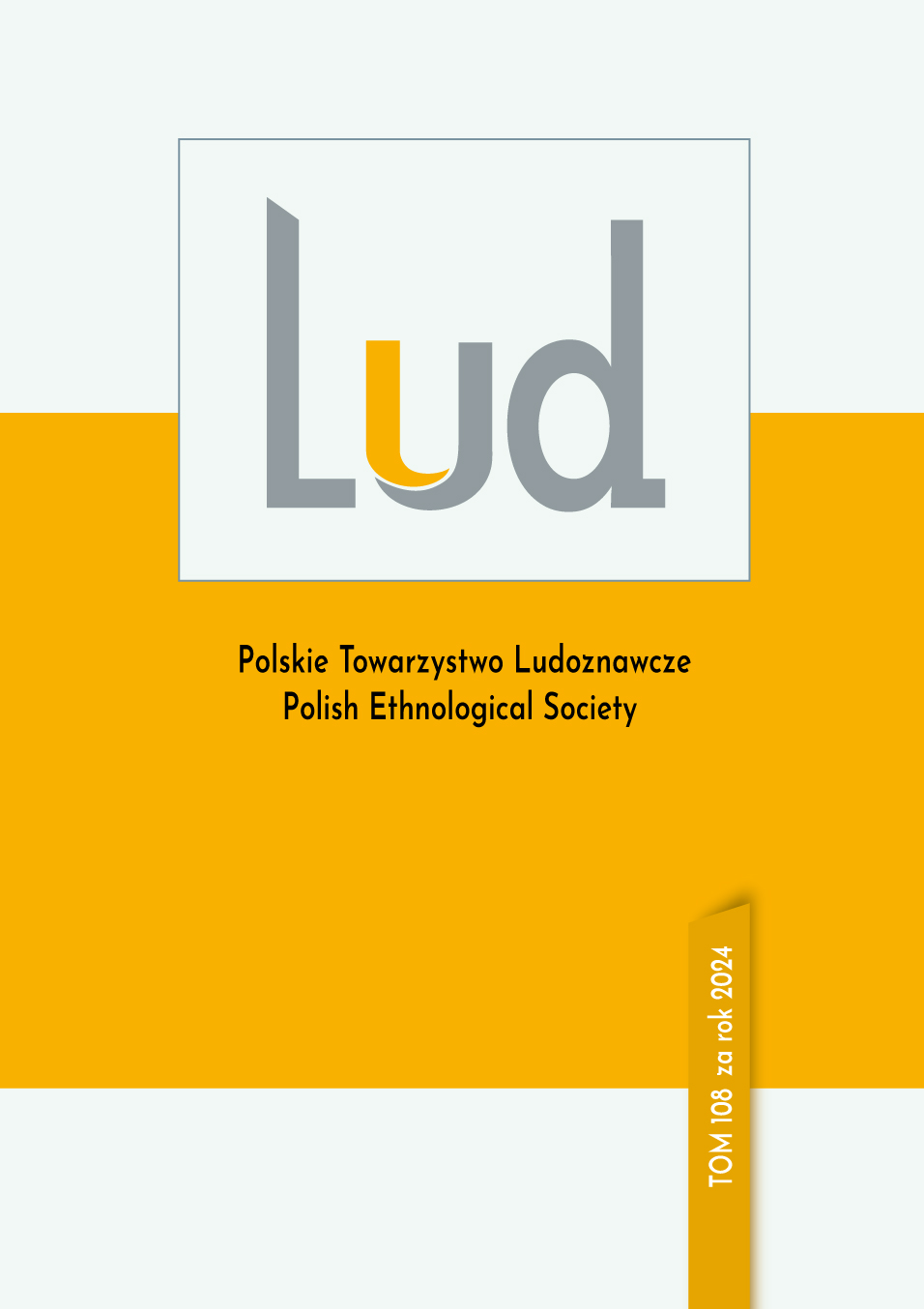The measure, the principle, the product
The wooden house in Eugeniusz Jaworski’s research
DOI:
https://doi.org/10.12775/lud108.2024.08Keywords
pre-metric measurements, wooden house, basement planning, carpenters tools, Silesian cultureAbstract
In the second half of the 1970s, Eugeniusz Jaworski undertook originally designed research into Upper-Silesian wooden architecture. While his searches initially fit into the formula of traditional ethnographic research, they were predominantly oriented at studying civilisation and its relationships with cultural history. His deepened analysis focused on the architectural documentation of a wooden house reconstructed in the Upper-Silesian Ethnographic Park. The analysis did more than merely report earlier results of ethnographic and architectural research, enhancing them with a discussion of areas that had been neglected: the carpenters’ knowledge and competence, including the precision of measurements and the principles of construction. Jaworski’s research was characterised by intellectual independence and analytical inquisitiveness. At the same time, he also avoided simplifications and patronising the so-called folk culture. In traditional ethnography, the aspect of the activity used to be ancillary to that of the item, which is why it was difficult to recreate the algorithm of the productive activities of the past. The main goal of the article is not to review the recently published monograph, but to point out the problems encountered by a researcher working on a project situated beyond the standard current of culture studies. The significance of the direction of studies laid out by Jaworski is confirmed by the latest work of Western researchers, the small number of which is compensated with their innovativeness and originality. As for a response from Polish researchers, some patience might be needed before it appears.
References
Bachleda-Dorcarz, W. (2015). Podhalański baca – pasterz, czarownik i protoplasta góralskiego zdobnictwa. Studia Artystyczne, t. 3, 139–144.
Barański, A., Warsza, Z.L. (2012). Miary na ziemiach polskich w dobie porozbiorowej. Pomiary, Automatyka, Kontrola, nr 12, 1137–1140.
Dzierżanowski, F.H. (1963). Inwentaryzacja architektoniczna, nr Frydek 3D Pszczyna I/A/2a. Warszawa: maszynopis powielany.
Easton, T. (2015). Apotropaic Symbols and Other Measures for Protecting Buildings against Misfortune. W: R. Hutton (red.), Physical Evidence for Ritual Acts, Sorcery and Witchcraft in Christian Britain. A Feeling for Magic (39–67). Basingstoke: Palgrave Macmillan.
Grabny, B. Zacharyasz, E. (2015). Chałupa z Frydka. Chorzów: Muzeum „Górnośląski Park Etnograficzny w Chorzowie”.
Hall, E.T. (1976.). Ukryty wymiar. Warszawa: Państwowy Instytut Wydawniczy.
Hall, E.T. (1984). Poza kulturą. Warszawa: Państwowe Wydaw. Naukowe.
Hall, E.T. (1987). Bezgłośny język. Warszawa: Państwowy Instytut Wydawniczy.
Hoggard, B. (2019). Magical house protection – the archeology of counter-witchcraft. New York: Berghahn.
Ihnatowicz, I. (1967). Vademecum do badań nad historią w XIX i XX wieku. Warszawa: Państwowe Wydawnictwo Naukowe.
Jaworski, E., Kosowska E. (1994). Antropologia i hermeneutyka: o tekstach Józefa Ligęzy. Katowice: Wydawnictwo „Śląsk”.
Jaworski, E. (1967). Uwagi o współczesnym stanie tradycyjnej kultury w Górnośląskim Okręgu Przemysłowym: Kroniki Miasta Zabrza, t. 1, 18–56.
Jaworski, E. (1971). Badania nad współczesnymi przeobrażeniami kultury ludowej na Górnym Śląsku. Bytom: Muzeum Górnośląskie.
Jaworski, E. (2022). Człowiek, przedmiot, reguła. Studium kultury budowania na Górnym Śląsku. Katowice: Wydawnictwo „Śląsk”.
Karłowicz, J. (1884). Chata polska. Pamiętnik Fizyograficzny, t. 4, 383–411.
Kosowska, E., Jaworski, E. (1987). Antropolog w pułapce epistemologii (rec.). Literatura Ludowa, nr 2, 61–66.
Kula, W. (1970). Miary i ludzie. Warszawa: Państwowe Wydawnictwo Naukowe.
Kulig, A. Filipowski, S. Wójtowicz, M. (2020). Nowe technologie w badaniach zabytków architektury. Analiza parametryczno-algorytmiczna gotyckiego sklepienia w Szydłowcu. Wiadomości Konserwatorskie, nr 64, 59–74.
Mokranowska, Z. (2021). Kulturoznawca powinien interesować się wszystkim, Gazeta Uniwersytecka UŚ. Miesięcznik Uniwersytetu Śląskiego, nr 7.
Moszyński, K. (1929). Kultura ludowa Słowian, 1: Kultura materjalna. Kraków: Polska Akademia Umiejętności. Skład Gebethnera i Wolfa.
Musioł, L. (1963). Dawne miary zboża na Górnym Śląsku (przyczynek do metrologii śląskiej). Opole: Instytut Śląski w Opolu.
O.G. (1952). Sprawozdanie XXVII Walnego Zgromadzenia Polskiego Towarzystwa Ludoznawczego w Katowicach. Polska Sztuka Ludowa, nr 3, 183–184.
Ong, W.J. (1992). Oralność i piśmienność: słowo poddane technologii. Lublin: Redakcja Wydawnictw Katolickiego Uniwersytetu Lubelskiego.
Pauch, S. (2019). Graffita na murach budowli sakralnych w Polsce północnej. W: Ł. Burkiewicz i in. (red.), Polska kultura religijna. Studia o polskiej religijności na przestrzeni wieków (509–524). Kraków: Wydawnictwo Naukowe Akademii Ignatianum.
Smith, L. (1997). Compass, cut circle and daisy wheel. Mortice and Tenon, nr 5, 3–5.
Smith, L. (2020). Architectural Geometry: A Rare Geometrical Record from Rural Devon, Exeter: Historic Building Geometry in partnership with the UK Carpenters’ Fellowship.
Stamm, E. (1935). Miary długości w dawnej Polsce, Wiadomości Służby Geograficznej, nr 3, 350–380.
Szczupak, D. (2022). Rozeta wyryta na filarze bazyliki katedralnej św. Jana Chrzciciela i św. Jana Ewangelisty w Toruniu – chronologia i funkcja. Ochrona Zabytków, nr 2, 73–83.
Środulska-Wielgus, J., Wielgus, K. (2018). Inwentaryzacja zasobów naturalnych i kulturowych do szlaku kultury wołoskiej na terenie województwa małopolskiego. Kraków: Politechnika Krakowska im. Tadeusza Kościuszki.
Downloads
Published
How to Cite
Issue
Section
License
Copyright (c) 2024 Anna Gomóła, Ewa Kosowska

This work is licensed under a Creative Commons Attribution-NoDerivatives 4.0 International License.
- The authors give the publisher (Polish Ethnological Society) non-exclusive license to use the work in the following fields:
- recording of a Work / subject of a related copyright;
- reproduction (multiplication) Work / subject of a related copyright in print and digital technique (ebook, audiobook);
- marketing of units of reproduced Work / subject of a related copyright;
- introduction of Work / object of related copyright to computer memory;
- dissemination of the work in an electronic version in the formula of open access under the Creative Commons license (CC BY - ND 3.0).
- The authors give the publisher the license free of charge.
- The use of the work by publisher in the above mentioned aspects is not limited in time, quantitatively nor territorially.
Stats
Number of views and downloads: 474
Number of citations: 0



